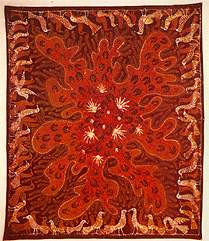|
BATIK
In
1965 batik was yet another craft to be introduced to the children
at the center. By choosing batik, Ramses wanted to demonstrate
that creativity could be brought out through any medium -
particularly one that had not been present in Egypt before.
A second reason involved the question of the pace of the work.
In contrast to weaving, batik requires fast work. Its use
of molten wax and phase dying presented a new challenge requiring
planning and an altogether different faculty.
Those
who learned this technique had to be quick of hand and eye.
In batik, the cloth is dipped repeatedly into different. dyes
which range from clear to opaque. Elements of the design,
which are of the same color, are drawn in wax before dipping
the cloth into the next dye. Unlike weaving, batik demands
that the child should have a complete idea of what he wants
to represent before starting work. As with all the other activities
at the center, here too the artists do not make preliminary
designs.
The
versatility of batik allows one to make tablecloths, furnishing
fabrics and wall pictures. For practical purposes, chemical
dyes are necessary for this technique. Today Yoanna Wissa
Wassef continues to guide these batik painters who have achieved
quite remarkable results over the years. Ramses Wissa Wassef's
|

|
 Overflowing Pond - 1989
Overflowing Pond - 1989 |
experiment
has now continued for over half a century. His daughter Yoanna
describes three fundamental elements, which she notes as having
assured the success of the experiment through the years.
They
are, love of humanity, mutual confidence between child and
adult, and the patience to give the child the time he needs
to develop the gifts which nature has given him. With these
three elements, Ramses has shown that given the right circumstance
all children have the potential to create. He has taken the
children on a creative journey, and thread by thread, has
lead them to piece together the beauty of life. This is in
essence what all those at the center share through their work
- the varied impressions of life and lasting details of beauty.
|
|